16.5: Practice
The principles of school-age care pedagogy underpin practice. Educators draw on a rich repertoire of pedagogical practices to promote children’s learning by:
- adopting holistic approaches
- collaborating with children
- planning and implementing play and recreational activities
- acting with intentionality
- creating physical and social school-age care environments that have a positive impact on children’s development, well-being and community-building
- valuing the cultural and social contexts of children and their families
- providing for continuity in experiences and enabling children to have successful transition
- using reflection and documentation about children’s well-being and learning to inform and evaluate programs and to support children in achieving outcomes.
Holistic Approaches
School-age care educators take a holistic approach to their roles and responsibilities, recognizing the connectedness of mind, body and spirit. They focus attention on children’s physical, personal, social, emotional and spiritual well-being as well as cognitive aspects of learning as it pertains to life-long learning. They are particularly concerned with how children’s social and physical development and well-being influences capacity and potential to become effective citizens. Each outcome is viewed as being integrated and interconnected.
An integrated, holistic approach focuses on connections to the social and natural worlds. Educators foster children’s capacity to value and respect the broader social environment and to be world-wise; and as well understand and appreciate the natural environment and the interdependence between people, plants, animals and the land.
Educators recognise the connections between children, families and communities and the importance of reciprocal relationships and partnerships. They see learning as a social activity and value collaborative activities and community participation.
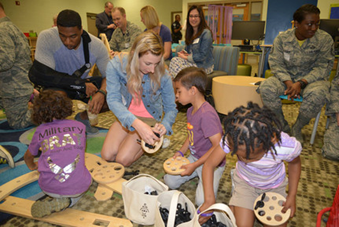
Each school-age care setting can be considered as a community itself, just as it is also part of the local and global community. As such, the school-age care community has the power to affect and be affected by issues within and outside the setting. School-age care educators consider children’s needs including nutrition and safety. They see children as capable and responsible, and provide places for them to socialise and play with friends and to relax and have fun. School-age care settings are places to learn about self, others and the world – in other words learning about living and learning through living.
Collaboration with Children
School-age care educators are responsive to all children’s strengths, abilities and interests. They value and build on children’s strengths, skills and knowledge to ensure their well-being, motivation, and engagement in experiences. They respond to children’s expertise, cultural traditions and ways of knowing, the multiple languages spoken by some children, particularly Aboriginal and Torres Strait Islander children, and the strategies used by children with additional needs to negotiate their everyday lives.
Responding to children’s ideas and play forms an important basis for program decision-making. In response to children’s evolving ideas and interests, educators assess, anticipate and extend children’s ideas via open ended questioning, providing feedback, challenging their thinking and guiding their actions.
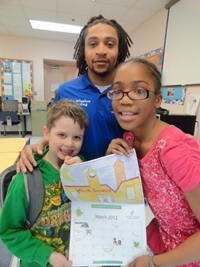
Responsive relationships are significant features of school-age care settings. This form of collaborative engagement is evidenced between educators and children, among children, between educators and parents and various stakeholders including schools, working to support children, families and the community.
Responsive relationships are strengthened as educators and children share decisions, respect and trust each other and learn together. Responsiveness enables educators to respectfully enter children’s play and ongoing projects, stimulate their thinking and enrich their growth and development. Responsive relationships with families and the local community including schools, enables educators to establish safe and secure environments for children.
Learning through Play
Play and recreational activities provide opportunities for children to learn as they discover, create, improvise and imagine. When children play with other children they create social groups, test out ideas, challenge each other’s thinking and build new understandings. Play provides a supportive environment where children can ask questions, solve problems and engage in critical thinking. Play can expand children’s thinking and enhance their desire to know and to learn. In these ways, play can promote positive dispositions towards learning. Children’s immersion in their play illustrates how play enables them to simply enjoy being.
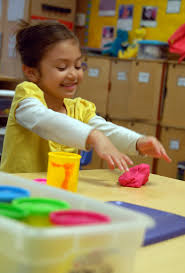
School-age care educators take on many roles in play and recreational activities with children and use a range of strategies to enrich development. They allow time and create spaces that encourage children to explore, build relationships, solve problems, create and construct. They also recognise spontaneous ‘teachable moments’ as they occur, and use them to build on children’s experiences.
Educators actively support the inclusion of all children in play and recreational activities. They also help children to recognise when play is unfair and offer constructive ways to build a caring, fair and inclusive community.
In school-age care settings, there is a myriad of recreational and play experiences that foster children’s development and encourages valuable learning. Play in school-age care settings will often differ from that of preschool-aged children. According to Piaget’s theory of cognitive development, most school-age children will have moved, or be moving, into the concrete operational stage of development. As they get older, school-age children place more importance on peer interactions. ‘Peers become partners who must learn to negotiate, compromise, share and defend themselves as equals’ (Nixon & Gould 2005, p.173).
Play also provides children with opportunities to practice skills taught at school or learned at home, and to reinforce the learning that has occurred. The following table addresses the ways to incorporate different types of play into school-age care.
Table 16.1: Way to Incorporation Different Types of Play into School-Age Care
| Types of Play | Ways to Incorporate Into School-Age Care |
|---|---|
| Dramatic Play | Provide materials that will foster role play Create spaces for dramatic play Facilitate more complex, pre-planned dramatic productions for older children |
| Games with Rules | Provide opportunities for team games and sports Balance competitive games with experiences in which the whole group works towards a common goal Be involved in card and board games to ensure they are positive experiences for children |
| Play Rituals | Mixed-age groups are ideal places for these to be handed down Provide space, materials, and time for games like hopscotch, four square, clapping games, chants, and hide-and-seek |
| Rough and Tumble Play | Provide opportunities for this play with educator support and guidance to facilitate this Consider structured experiences, such as pillow fighting, pool noodle sword fights, and sumo suits Have a specific space with rules Ensure close supervision (can act as umpire/referee) |
| Collecting | Develop a policy and procedures on how collections can be traded (or not) |
| Excursions | Provide opportunities for children to connect to their communities, have stimulating and different experiences, and test out skills in a different context |
Intentionality
Intentionality refers to actions that are deliberate, purposeful and thoughtful. Educators who engage in intentional actions recognise that learning occurs in social contexts, and that interactions and conversations are vitally important for learning. They actively promote children’s learning through worthwhile and challenging experiences and interactions that foster high-level thinking skills and they seize opportunities in activities and conversations to extend or affirm children’s learning. They listen with intent to the conversations of children and use strategies such as modelling and demonstrating, open questioning, speculating, explaining, and engaging in shared thinking and problem solving to extend children’s thinking and learning. Educators move flexibly in and out of different roles and draw on different strategies as the context changes. The documentation and monitoring of children’s well-being and engagement with learning life skills and citizenship supports effective program planning. Intentionality utilises professional knowledge and strategies that reflect contemporary theories and research concerning children’s play, recreational and learning.
School-age care educators are conscious of making the most of opportunities to follow up children’s needs and interests. They make use of spontaneous ‘teachable moments’ to scaffold children’s development. These incidental opportunities are significant and meaningful to children’s being and becoming and achievement of the outcomes.
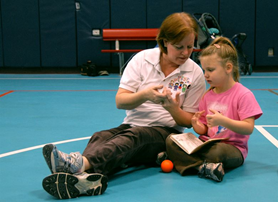
Environments
School-age care environments are welcoming spaces when they reflect and enrich the lives and identities of children and families participating in the setting in response to their interests and needs. (See Appendix B for a sample school-age care program classroom.) Environments that support well-being and development are vibrant and flexible spaces that are responsive to the welfare and abilities of each child. They cater for different needs and interests and invite children and families to contribute ideas and questions. Educators can support engagement by allowing time for meaningful interactions, by providing a range of opportunities for individual and shared experiences, and by finding opportunities for children to go into and contribute to their local community.
Resources need to reflect the interests and capabilities of the children that are sharing the environment and be accessible to children so they can choose and be responsible for their actions. Access to digital technologies can enable children to locate global connections and resources, and encourage new ways of thinking and communicating.
School-age care environments and resources can also emphasise accountability for a sustainable future and promote children’s understanding about their responsibility to care for the environment, day to day and for long-term sustainability. These spaces promote the development of life skills such as growing and preparing food, waste reduction and recycling.
School-age care settings are commonly located in a variety of venues and many are in shared facilities. The space should be flexible enough to allow for the range of activities necessary for children to participate in opportunities to achieve the outcomes. The environment should:
- Welcome the social nature of school-age children
- Provide an aesthetic beauty
- Be organized
- Provide rich possibilities and choices
- Invite children to undertake exploration and problem-solving
- Facilitate cooperation and negotiation
- Include quiet, comfortable spaces
- Incorporate structure and unstructured experiences
- Provide a range of recreational experiences
- Be designed to meet the needs of a diverse group of children (of differing ages, abilities, interests, and needs)
- Have spaces for both small and large group gathering/activities
- Encourage complex and creative thinking through open-ended materials
- Promote opportunities for sustained shared thinking and collaborative activities
- Recognize the importance of active play
- Include outdoor play in a natural environment and/or with natural materials
- Have an established routine
- Be more home-like; warm and cozy
- Nurture a sense of belonging
- Have a culture that sets the right tone
- Involve the rituals that are respectful and inclusive of all children and families
- Overcome obstacles (such as being in a shared space)
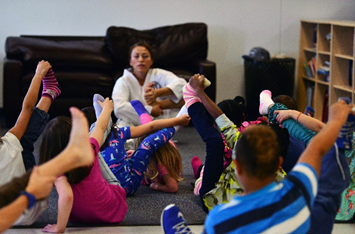
Children report that they value a space:
- that is and makes them feel safe
- feels positive and friendly
- where you can talk about your feelings and seek help for social difficulties
- outside that provides gross motor experiences
- inside that is organized and arranged for a purpose
- in which equipment, materials, personal belongings, and creations are stored safely
- that is decorated by displaying their work and creations
- with some natural elements (trees, animals, water, and gardens)
Here are some quotes from children about their school-age spaces:
“School-age care makes me feel a positive feeling, like a feeling I get when I go to my grandma’s, knowing someone really, really cares for me.”
“It’s comfortable and safe, it’s warm in winter and you know you have someone there to stay with you.”
Vignette
“Creating a Sensory Sensitive Environment”
Creating a sensory sensitive environment School-age care can be especially challenging for a child with a sensory processing disorder. Children are expected to process a wide range of sensory input in the environment simultaneously. For some children, inefficiencies in sensory processing impair their ability to do this. Therefore providing a space for children to retreat to and engage in experiences which help them to self-regulate is important for their successful inclusion in the school-age care setting.
After working with the Principle and Special Education Coordinator, visiting local elementary schools to look at their programs, talking to staff about resources and training, attending a workshop, we created a sensory sensitive and responsive environment which included beanbags, tents, music, lava lamps, weighted blankets, soft toys and a fish tank. The room has been used by children with autism spectrum disorder and children with developmental trauma. It has also proved a useful resource to engage children who may be reticent to attend school or the school-age care program.
Cultural Competence
Educators who are culturally competent respect multiple cultural ways of knowing, seeing and living. They celebrate the benefits of diversity and have an ability to understand and honour differences. This is evident in everyday practice when educators demonstrate an ongoing commitment to developing their own cultural competence in a two way process with children, families and communities.
Educators view culture and the context of family as central to children’s sense of being and belonging, and to success in lifelong learning. Educators also seek to promote children’s cultural competence.
Cultural competence is much more than awareness of cultural differences. It is the ability to understand, communicate with, and effectively interact with people across cultures. Cultural competence encompasses:
- being aware of one’s own world view
- developing positive attitudes towards cultural differences
- gaining knowledge of different cultural practices and world views
- developing skills for communication and interaction across cultures.
Continuity and Transitions
School-age care settings are situated in complementary relationships with homes, schools and community spaces with different places and environments having their own purposes, expectations and ways of doing things. In learning life skills children draw on the understandings, skills and attitudes from the range of settings in which they engage. Educators work with children, families, other professionals and the broader community to ensure successful transitions between settings and that children feel secure and confident. They assist children to understand the traditions, routines and practices of the settings to which they are moving and to feel comfortable with the process of change.
Children are likely to engage with other children and the educators in school-age care settings over a significant period of time. Ensuring children have an active role in preparing for transitions helps them to feel motivated to contribute and become engaged with the activities within settings. As children make transitions between settings (including school) educators from school-age care settings, schools and other children’s services, support the transitions by sharing appropriate information about each child’s capabilities and interests.

Change can be stressful and some individuals find it more difficult dealing with change than others. Change can occur on a day-to-day basis when children must transition from school-age care to the classroom and then back to school-age care again, or it may occur on a larger scale when children change schools or classrooms or experience a new addition to their family.
In exploring and understanding change and effectively managing change, children need support in:
- learning that change is easier to cope with if it is expected and timely
- using previous experiences of change to help cope with current change
- establishing meaningful routines which help during times of change choosing friends to
- bridge the gap between the familiar and unfamiliar
- recognizing that at times of change emotions may be difficult to manage
- learning that new opportunities can come with change
- gaining some control in the changes in their lives
- helping to support others during change
- realizing that change is a part of life.
Evaluation for Well-being and Learning
Educators gather knowledge about children’s well-being and learning as they reflect and engage in processes such as scanning, monitoring, gathering and analysing information about how children feel and what children know, can do and understand. It is part of an ongoing cycle that includes planning, documenting and evaluating children’s well-being, development and learning.
It is important because it enables educators in partnership with children, families and other professionals to:
- plan effectively for children’s well-being
- plan collaboratively with children
- communicate about children’s well-being and development
- determine the extent to which all children are progressing toward realising outcomes and if not, what might be impeding their progress
- identify children who may need additional support in order to achieve particular outcomes, providing that support or assisting families to access specialist help
- evaluate the effectiveness of environments and experiences offered and the approaches taken to nurture children’s well-being and to enrich children’s development
- reflect on pedagogy that will suit the context and children.
Educators use a variety of strategies to collect, document, organise, synthesise and interpret the information that they gather about children’s well-being and enrichment to evaluate the effectiveness of their programs. They search for appropriate ways to collect rich and meaningful information that depicts children’s well-being and development in context, describes their progress and identifies their strengths, skills and understandings. When school-age care educators and children collaborate about their well-being and experiences they use approaches that have become powerful ways to make the process visible to children and their families, educators and other professionals.
Educators make many informal observations and assessments on an ongoing basis. The goal in evaluation is to integrate these into a more planned and formal process to be able to evaluate the overall goals of the setting, as well as individual children’s needs and progress around well-being and learning.
One of the biggest challenges facing school-age care educators is efficient use of time and the need to document what is significant. What do you document? How do you know what is significant? You cannot possibly document everything and it tends to become meaningless if this occurs. Educators need to select the important moments. You can’t write in detail about every child, and you can’t do it every day! However, in time you can gather pictures and stories about all the children to give a better idea about who they are and their dispositions.

Educators are keen observers. They notice not only what children are doing, but also what and how they are playing and what they are saying during play. This puts them in a strong position to develop a program based on their observations. An emergent curriculum is one which:
- is child initiated, but framed by an educator: collaborative between child and adult
- builds on existing interests
- allows children to create, extend themselves and discover more
- is flexible, constantly developing and not done well in advance
- uses various forms of documentation.

